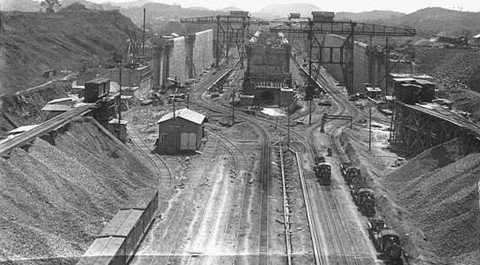
In response to yesterday’s post on the onetime vogue for mining-by-nuke, a treasured commenter asked:
I remember a rumor that someone proposed building an alternative to the Panama Canal (perhaps even at sea level) using nuclear explosives. Did you find any evidence of that in your research?
Indeed we did! This was actually the pet concept of Edward Teller, the man behind the H-bomb. In the interests of harnessing nuclear explosives for peaceful purposes, he founded Project Ploughshare. The organization is perhaps best remembered for its plans to use northwest Alaska as an aboveground testing site—a plan that never quite came to fruition due to local opposition, but still left behind plenty of radioactive nastiness. But Project Ploughshare also had dreams of blasting away a chunk of Panama, too, in the name of doubling the amount of sea traffic across the Isthmus. Time broke down the plans in 1964:
If nuclear explosives are placed in “strings” with the distance between them equal to half the diameter of the crater that a single shot would dig, and if they are exploded simultaneously, they will excavate a smooth-bottomed ditch, throwing the rock to the sides. One hundred shots, for instance, of 100 kilotons each, will dig a ditch 1,600 ft. wide, 350 ft. deep and 16 miles long. If its bottom is 60-odd ft. below sea level, it can serve as a spacious ship canal…
Ploughshare scientists believe that if they are careful about atmospheric and wind conditions when shots are fired, shock waves in the air will do no serious damage, but scientists are not so sure about ground shock waves. If 50 megatons must be exploded to cut a hole in a mountain ridge, ground shock may shake down buildings many miles away. Luckily, at least three of the most promising canal routes go through almost uninhabited country, with little but jungle and a few huts to be damaged. Another possible danger is radioactivity that may seep up through the bottom of the canal. There is no way to estimate how much will do so, but the strong current that will run through the canal should carry most of it away.
As with proposed mining endeavors, the chief attribute here was price—Project Ploughshare estimated that the new canal could be completed for a relatively paltry $500 million. But we have a hunch that decades of litigation linked to health consequences would’ve pushed that pricetag just a wee bit higher.
(Image via the Panama Canal History Museum)


Like gas stations in rural Texas after 10 pm, comments are closed.